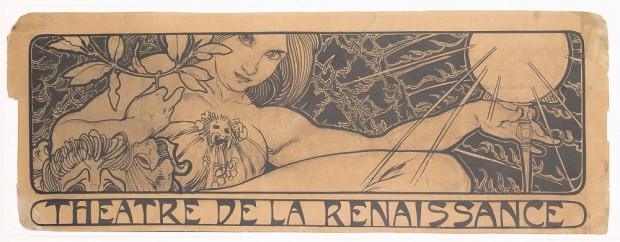
Sarah Bernhardt (13 works)
The Parisian actress Sarah Bernhardt (1844-1923) was the single most influential figure in Mucha’s life as an artist. It was his first poster for her, Gismonda, that made him famous and he grew both as a man and an artist through his professional collaboration and friendship with the greatest stage personality of the era.
Mucha met Sarah Bernhardt for the first time in late 1894. Legend says that on St. Stephen’s Day (26th December) Mucha, then a humble illustrator, was doing a favour for a friend, correcting proofs at Lemercier’s printing workshop, when the actress called the printer with an immediate demand for a new poster for her production of Gismonda. All the regular Lemercier artists were on holiday, so Mucha was turned to in desperation. Despite his lack of experience in designing posters, Mucha grabbed this opportunity and, to his own amazement, ‘La divine Sarah’ loved his work.
Mucha’s Gismonda posters were up all over Paris on the morning of 1st January 1895 and they were to revolutionise poster design. The long narrow shape, the subtle pastel colours and the stillness of the near life-size figure introduced a note of dignity and sobriety, which were quite startling in their novelty. The posters immediately became objects of desire to collectors, many of whom used clandestine methods to obtain them, either bribing bill stickers or simply going out at night and cutting them down from the hoardings.
Delighted with the success of Gismonda, Sarah Bernhardt immediately offered Mucha a contract to produce stage and costume designs as well as posters. Under this contract, Mucha produced six more posters for her productions: La Dame aux Camélias (1896), Lorenzaccio (1896), La Samaritaine (1897), Médée (1898), La Tosca (1898) and Hamlet (1899). Mucha applied to these posters the same design principle as that he had developed for Gismonda – the use of an elongated format with a single, full-standing figure of the actress placed in a raised shallow alcove like a saint.
The collaboration between Mucha and Sarah Bernhardt was mutually beneficial. Mucha’s posters immortalised the ‘divine’ image of the actress, consolidating her iconic status. For her part, Bernhardt was so enamoured with Mucha’s work that after 1896 she made use of his designs for all posters advertising her American tours. This promoted Mucha’s work and helped him secure a foothold to explore a new career in the United States after 1904.

